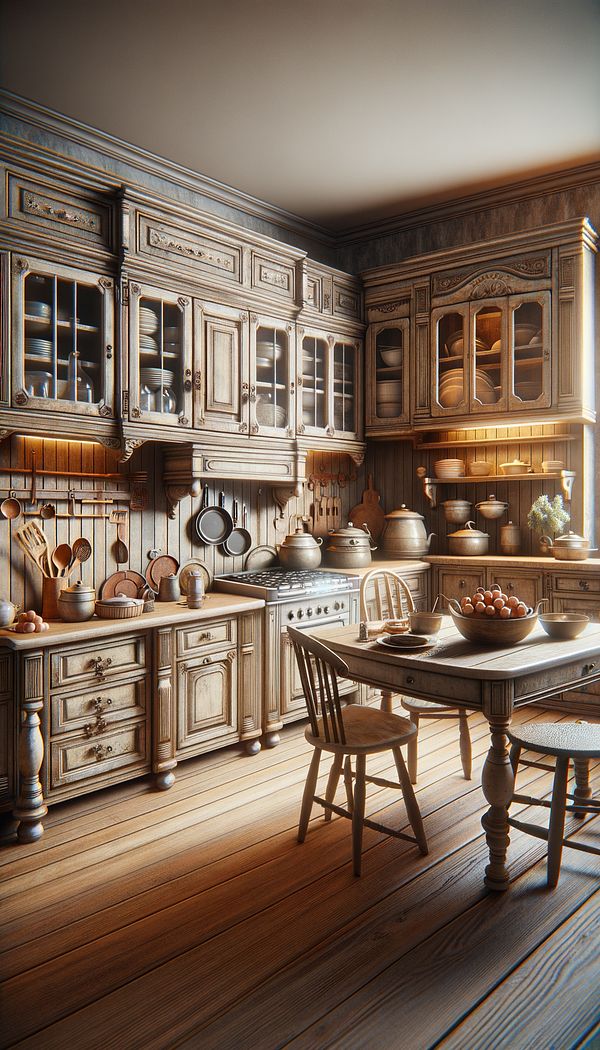What is Aging?
Aging, in the context of interior design, refers to a deliberate process to make an object or space appear older or more worn than it actually is.
Description
Aging is a decorative technique that involves giving new objects or spaces a worn, distressed, or antique appearance, making them seem older or more lived-in than they actually are. This is achieved through various methods, such as applying finishes that simulate wear and tear, distressing the material by hand, or using antiquing glazes that add a layer of perceived history to the item. The goal of aging is to imbue pieces with character and warmth, often creating a sense of nostalgia or a connection to the past.
This technique can be applied to a wide range of items, including furniture, wall treatments and finishes, flooring and carpets, and decorative objects. It's commonly used in interior design styles that seek to evoke a rustic, vintage, or historic ambiance, such as country, vintage, and shabby chic. While aging adds a visually appealing aesthetic, it also has the practical benefit of making surfaces more forgiving to wear and tear, as any new scratches or dents can blend into the already-distressed look. Aging is not just about achieving a certain style; it's also a celebration of imperfection and the stories that objects carry over time.
Usage
A common application of aging in interior design is in creating a vintage kitchen setting. Here, cabinets and furniture might be selected or treated to have a distressed wood finish, giving the impression of decades of use. This can be complemented with antique-looking hardware and accessories, vintage light fixtures, and wall finishes that feature aging techniques. The overall effect is a space that feels warm, inviting, and full of history, evoking a sense of continuity with the past.
FAQs
-
Is aging the same as antiquing?
While aging and antiquing are often used interchangeably in the context of interior design, there is a subtle distinction. Aging refers broadly to the process of making something appear older, which can be through wear, tear, or general distress. Antiquing specifically involves applying finishes or treatments that give an item an antique look, suggesting it has historical value or origins.
-
Can aging be applied to modern materials?
Absolutely, aging is not limited to natural or traditional materials. It can also be applied to modern materials like metal, plastic, or synthetic fabrics to give them a vintage or worn look. This versatility makes aging a popular tool in creating contrasts and bringing warmth to more contemporary interior design settings.
-
How durable are aged finishes?
Aged finishes are generally quite durable, especially if professionally done. These finishes involve layers of treatments and protective seals designed to withstand daily use while maintaining their aged appearance. However, the specific durability can vary based on the materials and techniques used.
Practical Application
When applying aging techniques, it's important to consider the overall design goal and context of the space. Start with a clear vision of the desired aged effect and select methods that suit the material you're working on. For DIY projects, practice on a small, inconspicuous area before committing to the entire piece. Remember, the key to successful aging is subtlety and layering – too much distressing or uneven application can detract from the authenticity and aesthetic appeal of the finished product.
-
Design Styles478 articles
-
Furniture Types599 articles
-
Decorative Techniques322 articles
-
Flooring & Carpets48 articles
-
Wall Treatments & Finishes157 articles
-
Arm CapsProtective coverings designed to fit over the arms of chairs and sofas.
-
Bungalow StyleBungalow Style refers to a compact, single-story house design with distinct architectural features.
-
Feather BedA feather bed is a type of mattress topper filled with feathers.
-
Bonnell CoilBonnell Coil is a type of coil used in innerspring mattresses for support.
-
Three-Way SwitchA three-way switch is a type of light switch that allows you to control a light from two different locations.
